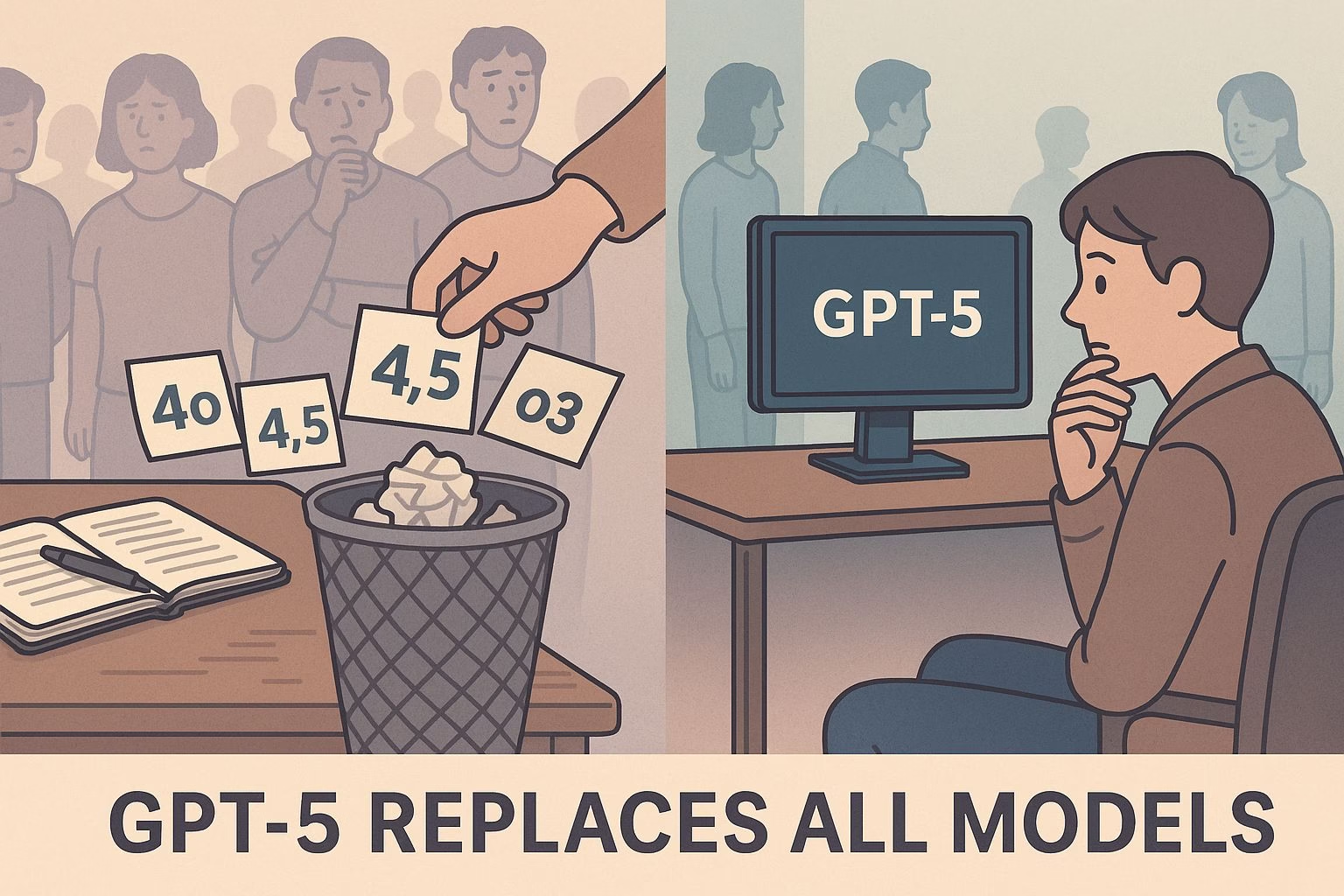ChatGPT-5 Rollout Sparks Backlash as Users Lose Access to Favorite Models
The release of ChatGPT-5 has triggered a wave of frustration among long-time users, not because it’s a new model, but because it arrived with the sudden removal of every other ChatGPT option.
Overnight, models like GPT-4o, 4.5, and o3 vanished from the interface for many paying subscribers. This was more than an inconvenience for those who had built entire workflows around model diversity.
For writers, roleplayers, researchers, and developers, each model had a specific role:
- 4o for immersive, personality-driven writing
- o3 for deep reasoning and fact-checking
- 4.5 for rich, descriptive storytelling
- and other versions for niche use cases.
Losing them all in a single update meant losing the ability to cross-verify outputs, preserve tone, and maintain the creative rhythm established over months of use.
The rollout has also been accompanied by usage limits that feel restrictive for those on paid plans.
For GPT-5, Plus subscribers now have a cap of 80 messages every three hours, with GPT-5 Thinking limited to 200 messages per week.
Once these limits are hit, the system either drops to a “mini” model or simply blocks further access until the timer resets.
Some users have reported that no fallback happens at all, leaving them locked out despite an active subscription.
For many, this isn’t just about numbers or speed. It’s about the loss of personality and depth. Conversations that once felt alive, warm, and adaptive now read more like stripped-down templates.
Creative writers in particular say that GPT-5’s outputs are shorter, colder, and more reactive, with less initiative in driving the narrative forward.
There’s a petition circulating at https://www.change.org/p/please-keep-gpt-4o-available-on-chatgpt for those who want legacy models reinstated, but until OpenAI changes course, users are weighing whether to adapt, downgrade, or explore other AI platforms entirely.
Comparison of Retired ChatGPT Models and GPT-5
| Feature / Model | GPT-4o | GPT-4.5 | o3 | GPT-5 |
|---|---|---|---|---|
| Primary Strength | Creative, personality-rich writing | Detailed, cinematic storytelling | Deep reasoning and fact-checking | General-purpose, faster responses |
| Tone & Personality | Warm, adaptive, engaging | Rich, descriptive, immersive | Neutral, logical, precise | More reserved, cautious |
| Memory Use | Strong for long-term roleplay and projects | Good at preserving tone across sessions | Strong factual recall | Capable but tone often shifts mid-project |
| Custom Instructions | Highly responsive | Highly responsive | Responsive | Responsive, but style reverts more easily |
| Message Limits | 80 msgs / 3 hrs (Plus) | 80 msgs / 3 hrs (Plus) | 200 msgs / week (Thinking) | 80 msgs / 3 hrs, 200 msgs / week (Thinking) |
| Availability | Removed | Removed | Removed | Default model |
| Best For | Roleplay, casual conversation | Immersive storytelling | Research, debugging | Everyday mixed use |
Why the sudden change hit so hard
OpenAI’s decision to replace every accessible model with GPT-5 wasn’t paired with prior notice, phased rollouts, or optional toggles for legacy versions.
This was a key point of frustration for users who had refined their workflows over months or years. Many weren’t just experimenting with different models; they relied on them for specific tasks.
For example, 4o was often chosen for its ability to deliver immersive, emotionally engaging dialogue that felt natural in roleplay or creative projects.
Writers who had fine-tuned instructions to maintain character personalities say those personalities now collapse into generic, overly cautious responses under GPT-5.
Others depended on o3 for research and logical reasoning, especially when fact-checking or debugging outputs from other models.
Losing the ability to cross-reference within the same platform is seen as a major step backward for accuracy and quality control.
The shift also disrupted memory-driven projects. Some users had extensive archives of conversations built with GPT-4o’s style and pacing.
Mid-story updates to GPT-5 changed the “voice” of these sessions, leading to tonal mismatches and abrupt breaks in continuity.
For roleplayers or ongoing collaborative stories, that change wasn’t cosmetic; it was the collapse of the experience they had been building. In these cases, moving to GPT-5 meant starting over or abandoning projects entirely.
Limits, caps, and technical complaints
Beyond the loss of choice, many paying subscribers found themselves facing stricter usage caps. Under the current setup for Plus users, GPT-5 is limited to 80 messages every three hours.
GPT-5 Thinking, the more reasoning-focused mode, has a weekly cap of 200 messages. When limits are reached, the intended fallback is to a smaller “mini” model, but users report this isn’t always happening.
Instead, the app sometimes locks them out completely until the window resets.
Support responses from OpenAI confirm that these limits are part of a staged rollout to “ensure stable service” as GPT-5 adoption scales.
The company’s official support email, su*****@****ai.com, is where users have been directing their complaints, though feedback so far has not produced any public policy changes.
For those on lower-cost tiers, the fallback to smaller models is supposed to offer continuity, but with the removal of favorites like 4o, there’s little comfort in the downgrade.
The issue is compounded for those in creative or professional workflows that demand high message counts.
Writers who routinely exceeded 80 back-and-forths in a few hours are now forced to work around forced downtime. Developers testing code at a rapid pace, or researchers conducting multi-threaded queries, hit the limits just as quickly.
For them, the problem isn’t only about quantity; it’s about interruption in momentum, which can derail productivity and make the platform less appealing compared to alternatives that offer more generous usage or custom hosting options.
The loss of creative personality
For many, GPT-5’s most jarring change is not in its speed or reasoning ability but in its tone. Conversations that once felt warm, adaptive, and full of subtle personality now read more like structured templates.
Writers who had spent months building character voices through memory and custom instructions say those voices have flattened. Where 4o could respond with nuance, banter, and sensory detail, GPT-5 often delivers shorter, more guarded replies.
This shift has hit roleplayers especially hard. In ongoing narratives, the model’s ability to take initiative in the story has declined. Instead of driving scenes forward, GPT-5 tends to wait for explicit prompts before adding depth or action.
In practice, this means more work for the user and less of the natural rhythm that made long sessions engaging. Some have compared it to losing a creative partner mid-project.
The dynamic that made 4o a favorite for collaborative storytelling has been replaced by a more cautious, reactive approach.
Even in less narrative-heavy contexts, the difference is noticeable. Casual conversation feels more reserved, and attempts to recreate the personality of previous models rarely succeed for long.
While custom instructions can help restore some of the lost energy, many report that the results still feel thinner than before.
The model is technically capable, but its default style leaves less room for the expressive qualities that users valued most.
How the community is responding
The backlash has been swift and organized.
Many subscribers have already downgraded or canceled their plans, citing both the loss of choice and the change in tone.
A petition is circulating at https://www.change.org/p/please-keep-gpt-4o-available-on-chatgpt urging OpenAI to restore access to legacy models.
The comments there echo the same themes seen in user forums: frustration at the sudden rollout, a desire for optional toggles, and the belief that removing model diversity is a step backward for both creativity and accuracy.
Some users have turned to direct outreach. The official support email, su*****@****ai.com, has been shared widely as the channel for complaints and feedback.
A few have drafted formal letters explaining how specific models supported their accessibility needs, asking that legacy options be restored for those with documented requirements.
Others have shifted their work entirely to competing platforms that still allow for model choice and more flexible customization.
Alongside the frustration, there is experimentation. Workarounds include building custom GPTs to simulate the style of older models, using alternative AI services with long memory windows, or adopting multi-tool setups that split different tasks between different providers.
While none of these perfectly replace the old model lineup, they demonstrate the determination of users to preserve the experiences they value.
The decision now sits with OpenAI on whether to keep GPT-5 as the sole option or bring back the variety that long-time subscribers say made the service worth paying for.
Where things could go from here
OpenAI could ease much of the backlash with a few targeted changes. Restoring legacy models as optional toggles for Plus and Pro users would immediately address the loss of choice without disrupting the broader move to GPT-5 as the default.
Allowing users to select older models for specific projects would also preserve long-running workflows, especially for writers and roleplayers who rely on consistent tone and pacing.
If legacy access is not coming back, the company could focus on closing the gap in GPT-5’s creative flexibility.
That means giving more control over output style, personality, and verbosity, so that users can shape the model into something closer to what they had before.
Expanding message limits for paying subscribers would also reduce the frustration of hitting caps mid-project.
For those unwilling to wait, alternatives are already in use. Some are moving to AI platforms that allow deeper customization and memory retention for long-form storytelling.
Others are building hybrid setups, combining GPT-5 with tools that excel in specific areas like roleplay or research.
What happens next will depend on how OpenAI balances its technical roadmap with the feedback pouring in.
GPT-5 may evolve into a model that satisfies both casual and creative users, but the current rollout has shown that cutting off familiar tools without warning risks alienating even the most loyal subscribers.
The demand is clear: users want choice, control, and the option to keep what already worked.

